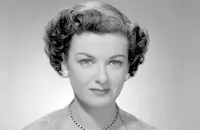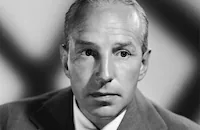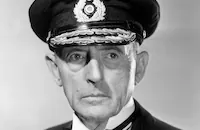The Man I Married

Brief Synopsis
Cast & Crew
Irving Pichel
Joan Bennett
Francis Lederer
Lloyd Nolan
Anna Sten
Otto Kruger
Film Details
Technical Specs

Synopsis
In July 1938, The Smart World magazine art critic Carol Hoffman prepares to leave New York with her husband Eric on a trip to Germany. Eric must go to Germany to help his father with the family business, but both he and Carol see the trip as an extended vacation. Dr. Hugo Gerhardt arrives at Carol's office to ask a favor. His brother, the renowned philosopher Hans Gerhardt of Berlin University, has been taken to the Dachau concentration camp. Hugo has raised $500 in bribe money and asks Carol and Eric to deliver it for him. Arriving by boat in Bremerhaven, Eric tells Carol he feels like a tourist, not a native. On the train to Berlin, Eric reads a German newspaper to Carol, telling her how, according to the journal, there is no unemployment in Germany and how German radios and cars are cheaper, yet superior, to their American counterparts. Seeing a train of prisoners, Eric and Carol are informed by a fellow traveler that they are Austrian forced labor. The traveler also comments on how inferior German products really are. At the Berlin train station, the couple is met by Freda Heinkel, Eric's old flame. Once at home, Eric's father Heinrich explains that the old Germany he knew is gone and that Eric must now either take over the family business or sell it. At a large military rally, Eric begins to feel that Germany is "alive, exciting," much to Carol's chagrin. Then, at a dance, Eric confesses to Carol that he wants to stay in Germany and run the family factory. Freda arrives and tells Carol that they cannot give the money to Hans Gerhardt, as he is a traitor to his country. Carol, despite this, vows to deliver the money as promised. At the Overseas News Service , Carol meets American reporter Kenneth Delane. When Carol asks about Hans, Ken tells her that Gerhardt died in Dachau of "acute appendicitis." Ken suggest that Carol give the money to Gerhardt's family. On the way to see the Gerhardts, Carol and Ken run into a Storm Trooper patrol, which is making Czech women and children pick up garbage in the streets. At the Gerhardt home, Frau Gerhardt thanks Ken and Carol, but refuses their offer to send her to America. When told the official cause of her husband's death, Frau Gerhardt informs them that Hans had his appendix removed twenty years earlier. After Carol returns home, Eric dismisses what she has seen as isolated incidents. When he informs Carol that he is having dinner with Freda and some Nazi officials, Carol calls Hitler "Schickelgruber" (his real name), a comment that Eric declares is grounds for divorce. That night, Carol attempts to help their neighbor Friehof hide his eldest son, who has just escaped from a concentration camp. When the Gestapo arrives, however, Friehof's youngest son turns them in. At Gestapo headquarters, Carol is interrogated by Herr Deckart, but Ken, using the power of the American press, gets her released. At Hitler's speech at the Berlin Sportspalast, Eric fully absorbs the Nazi idea, to Carol's horror. The next morning, Eric reveals to Carol that he has decided to stay in Germany permanently. When Carol protests, Eric admits that he has joined the Nazi party and is in love with Freda. Carol agrees to a divorce, but Eric refuses to let her take their son Ricky back to America with her. Ken offers his help in sneaking Ricky out of Germany, but Eric foils the plan. Heinrich confronts his son, however, telling him that the boy belongs with his mother. When Eric, with Freda's support, still refuses to give up Ricky, Heinrich tells him that his mother was Jewish. Repulsed, Freda leaves and Heinrich informs the shattered Eric that now he will have to suffer what he would have done to others. At the train station, Carol and Ricky leave Germany, as Ken tells them that he will be staying in Germany for the duration.

Director

Irving Pichel
Cast

Joan Bennett

Francis Lederer

Lloyd Nolan
Anna Sten

Otto Kruger

Maria Ouspenskaya

Ludwig Stossel
Johnny Russell
Lionel Royce
Fredrik Vogeding
Ernst Deutsch
Egon Brecher
William Kaufman

Frank Reicher

Charles Irwin
Lillian Porter
Lillian West
Walter Bonn
Glen Cavender
Hans Von Morhart
William Yetter
Carl Freybe
Ragnar Qvale
Rudy Frolich
John Stark
Tom Mizer
Hans Schumm
Davis Roberts
Greta Meyer
Albert Geigel
Eleanor Wesselhoeft
Diane Fisher
John Hiestand
Leyland Hodgson
Arno Frey
Eugene Borden
Harry Depp
Crew
Joseph E. Aiken
Travis Banton
David Buttolph
Richard Day
Oliver H. P. Garrett
Raymond Griffith
Roger Heman
Thomas Little
Peverell Marley
Booth Mccracken
Hans Peters
Robert Simpson
Darryl F. Zanuck

Film Details
Technical Specs

Articles
The Man I Married
Joan Bennett stars as American art critic Carol Hoffman, a successful professional woman at a big city newspaper. Francis Lederer is her German-American husband Eric Hoffman, who is eager to take her and their thoroughly American son (Johnny Russell) to his homeland. What is supposed to be a short stop in a European vacation becomes a long stay as Eric falls under the sway of Nazism, enthusiastically shouting "Sieg Heil!" at rallies he attends with a former schoolmate (Anna Sten), a party faithful who embodies the Aryan ideal.
Part propaganda movie, part detective film, and part escape thriller, The Man I Married presents Carol as a kind of civilian investigator discovering the openly brutal treatment of Jews in the streets and the blind fanaticism of the German people. Lloyd Nolan co-stars as the affable American correspondent who becomes her guide and ally as her husband transforms into a pro-Hitler zealot during their stay. Where previous films avoided the word "Jew," there is no hesitation in this film, and newsreel footage of actual Nazi rallies and military parades adds chilling realism to the dramatic recreations.
There are no German-born actors in the cast but the film features some of Hollywood's great European-born actors playing the German characters. In addition to Prague-born Francis Lederer as the man Joan Bennett married and Russian Anna Sten as his Aryan sweetheart, the film co-stars the great Russian-born Maria Ouspenskaya, who trained under Stanislavsky and was an influential acting teacher in the U.S., and Austrian-born Ludwig Stössel, a German movie star and a Jew who fled Europe when Hitler came to power.
New York Times film critic Bosley Crowther praised the film's restraint and "frank and factual" treatment: "[H]ere is a 'hate' film which, at least, lets the villains speak a word for themselves, which pictures the German Nazis as hypnotized zealots rather than congenital brutes and which tells a simple, straightforward story without wild dramatics and therefore with conviction."
Sources:
"'The Man I Married,' a Drama of Inside Germany," Bosley Crowther. The New York Times, August 3, 1940.
Hollywood and Hitler: 1933-1939, Thomas Doherty. Columbia University Press, 2013.
IMDb
By Sean Axmaker

The Man I Married
Quotes
Trivia
Notes
The working title of this film was I Married a Nazi. Many contemporary sources indicate that Oscar Schisgall's novel Swastika was first published as a serialized story in Liberty magazine. George Sanders and Richard Greene were cast in the film at the start of production. According to a Twentieth Century-Fox press release, Saunders, originally cast in the "Eric Hoffman" role, was still acting in Foreign Correspondent, which had gone over schedule, and was forced to give up his role in this film. Greene, cast as "Kenneth Delane," was replaced after he became bed-ridden for two weeks with the flu. Hollywood Reporter production charts list William Gargan in the cast, but his participation in the final film has not been confirmed. Press releases report that over "two hundred" applicants were seen for the role of Adolf Hitler in this film. Carl Ottman was finally cast in the role, but his performance was cut from the film. In the scene at the Berlin Sportspalast, Hitler's actual voice was used. Press materials also indicate that actual Nazi propaganda was used in the set design of the film. In addition, press releases note that 1,000 Nazi uniforms were used in this film, though they were shared with another Twentieth Century-Fox film, Four Sons. The following was reported by Twentieth Century-Fox press materials: during a scene that required fifty young boys to dress in Nazi uniforms, eight boys walked off the set, unable to play their characters. A new type of set construction was featured in this film, in which canvas, instead of wood, was used, which led to a twenty-five per cent savings in construction costs. For the scene in which storm troopers forced Czechs to pick up garbage in the street, there was not enough garbage available at the Twentieth Century-Fox cafeteria, so trucks were sent out to collect garbage from nearby Beverly Hills housewives. A New York Times article states that this film, along with other anti-Nazi propaganda films from Hollywood did not perform well at the box office. The article speculated that audiences were either bored by the constant Nazi depravities or objected to "having a philosphic attitude rammed down their throats." An undated Hollywood Reporter clipping from the AFI Mayer Library states that Twentieth Century-Fox and the German consul had heated discussion over this film, with the German consul threatening to refuse distribution of Twentieth Century-Fox films in his country. According to modern sources, the film was pulled shortly after its release in an attempt to stay neutral in the then-European conflict and so as not to offend "a friendly foreign country." Thus, the working title was changed and few prints of the film were struck.














